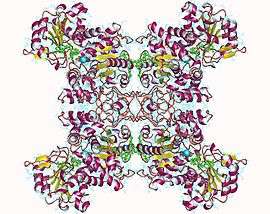Malate dehydrogenase (oxaloacetate-decarboxylating)
In enzymology, a malate dehydrogenase (oxaloacetate-decarboxylating) (EC 1.1.1.38) is an enzyme that catalyzes the chemical reaction
- (S)-malate + NAD+ pyruvate + CO2 + NADH
| malate dehydrogenase (oxaloacetate-decarboxylating) | |||||||||
|---|---|---|---|---|---|---|---|---|---|
 malic enzyme tetramer, Human | |||||||||
| Identifiers | |||||||||
| EC number | 1.1.1.38 | ||||||||
| CAS number | 9080-52-8 | ||||||||
| Databases | |||||||||
| IntEnz | IntEnz view | ||||||||
| BRENDA | BRENDA entry | ||||||||
| ExPASy | NiceZyme view | ||||||||
| KEGG | KEGG entry | ||||||||
| MetaCyc | metabolic pathway | ||||||||
| PRIAM | profile | ||||||||
| PDB structures | RCSB PDB PDBe PDBsum | ||||||||
| Gene Ontology | AmiGO / QuickGO | ||||||||
| |||||||||
Thus, the two substrates of this enzyme are (S)-malate and NAD+, whereas its 3 products are pyruvate, CO2, and NADH.
This enzyme belongs to the family of oxidoreductases, specifically those acting on the CH-OH group of donor with NAD+ or NADP+ as acceptor. The systematic name of this enzyme class is (S)-malate:NAD+ oxidoreductase (oxaloacetate-decarboxylating). Other names in common use include malic enzyme, pyruvic-malic carboxylase, NAD+-specific malic enzyme, NAD+-malic enzyme, and NAD+-linked malic enzyme. This enzyme participates in pyruvate metabolism.
Structural studies
As of late 2007, 6 structures have been solved for this class of enzymes, with PDB accession codes 1DO8, 1EFK, 1EFL, 1GZ3, 1LLQ, 1O0S, 1PJ2, 1PJ3, 1PJ4, 1PJL, 1QR6, 1WW8, and 2DVM.
See also
References
- Kaufman S, Korkes S, Del Campillo A (1951). "Biosynthesis of dicarboxylic acids by carbon dioxide fixation. V Further studies of the "malic" enzyme of Lactobacillus arabinosus". J. Biol. Chem. 192: 301–312.